

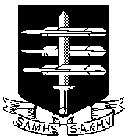 The South African
The South African
In a way it was a case of Adolph vs Adolf and then Malan vs Malan. He became one of the most recognisable figures in aerial combat against the German Luftwaffe during the early days of the Second World War in the Battle of Britain. After the war he victoriously returned to the country of his birth and became the leader of the Torch Commando who strongly opposed the system of apartheid and racial segregation implemented by the then Prime Minister D.F. Malan and his National Party.
The decorated Royal Air Force fighter ace and human rights activist was Group Captain Adolph Gysbert (AG) Malan. But he was better known by his nickname "Sailor", as a result of his earlier training at the South African Training Ship (SATS) General Botha in Simon's Town and a career at sea in the merchant marine. Today this maritime heritage is carried forward by the SATS General Botha Old Boys Society who amongst others maintains an important historic exhibit at the South African Naval Museum in Simon's Town.
On Sunday 3 December, the South African Naval Museum hosted a Memorial Lecture, organised by the SATS General Botha Old Boys Society in honour of "Sailor" Malan. This year marked the 50th anniversary of his untimely passing due to Parkinson Disease (on 17 September1963). The guest speaker was Dr Yvonne Malan who had for years fervently advocated the recognition of Malan in his own country.
The event attracted a sizable crowd of almost 80 and yielded a valuable question and answer session. One of the most poignant comments came from former Chief of the Air Force, Lieutenant General Carlo Gagiano, who lamented the lack of historic attention given to other South African fighter pilots such as "Dutch" Hugo, Jack Frost, Pat Pattle and Chris le Roux. Like Malan, they had simply been forgotten (not to mention another former "Botha Boy", and Victoria Cross recipient, Lancaster bomber pilot John Nettleton).
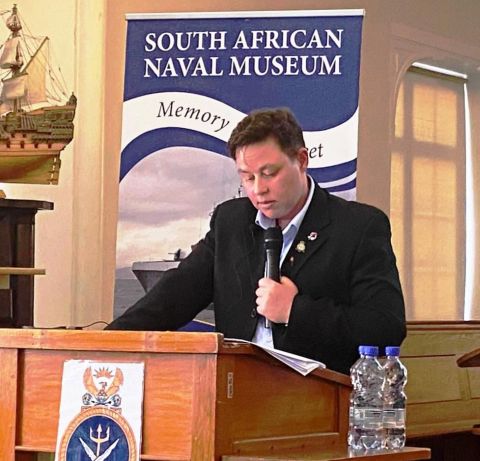
Guest speaker Dr Yvonne Malan
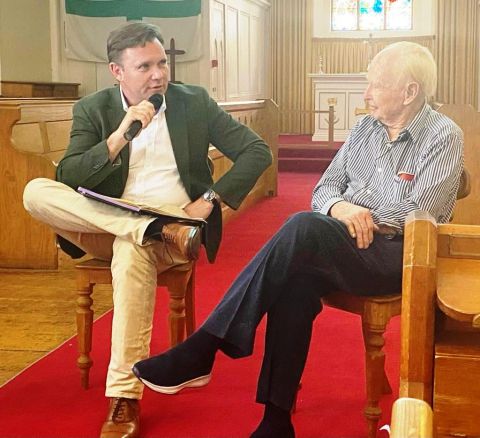
Another family member, Mr Riël Malan,
interviewed Dr Crispian Trace,
a friend of "Sailor" Malan.
"Relighting the torch" of "Sailor" Malan's legacy may just have been the ignition needed to rekindle a re-evaluation and re-appreciation of the contribution made by these men during the Second World War. To conclude the Memorial Lecture, a temporary exhibition was unveiled by the curator of the Naval Museum, Commander Leon Steyn, in honour of Group Captain A.G. "Sailor" Malan, inside the SATS General Botha display area.
Three days later, on 6 December, at an official ceremony held in the City Council Chambers, the City of CapeTown bestowed posthumous Civic Honours on "Sailor" Malan. Dr Yvonne Malan was there to receive the award from Mayor Geordin Hill-Lewis. Apart from Malan, the event saw twelve other exceptional Capetonians honoured, who had made significant contributions to society in Cape Town and throughout the world.
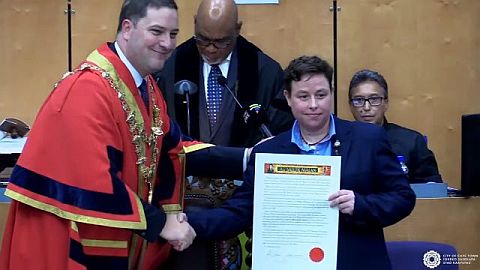
Mayor of Cape Town, Geordin Hill-Lewis,
presenting the Civic award to
Dr Yvonne Malan on 6 December 2023
the scroll reads:
"In honour of a true war hero and early
anti-apartheid activist, the City of Cape
Town bestows Civic Honours on AG Malan."
Did you know?
The large white sign marked "GB". on the slope of the mountain above the South African Naval College refers to the SATS General Botha, after the training institution that was based there, and not to the town of Gordons Bay itself.
Who was “Sailor” Malan?
Adolph Gysbert (A.G.) Malan is remembered as a South African World War 2 hero. He served as a Spitfire fighter pilot in the Royal Air Force (RAF) and later a human rights activist who took a principled stand against apartheid in the 1950s.
Born in the Boland town of Wellington in 1910, Malan became a naval cadet at the age of 14 and an officer cadet at 19. This would later earn him the nickname "Sailor" among his fellow RAF pilots. He joined the Royal Naval Reserve in 1932 and signed up for the RAF's pilot corps in 1935. His fighter pilot career included being given command of 74 Squadron in August 1940 and leading them at the height of the Battle of Britain. On 11 August the squadron completed four missions and reportedly shot down 38 aircraft. The day became known as "Sailor's August 11th". Malan ended his career as one of the highest scoring pilots in the RAF.
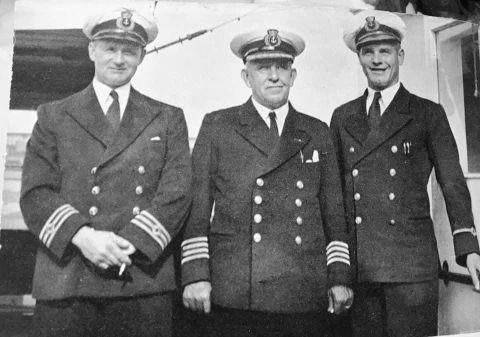
Sailor Malan on the right as a
junior officer on the Sandown Castle
Upon his return to South Africa he was dismayed at the newly elected National Party's introduction of apartheid. In the early 1950s he joined a liberal anti-apartheid protest movement called the Torch Commando, borne out of a group of like-minded war veterans called the Springbok Legion, and was elected as its President. Founded in defence of Coloured people's voting rights, the Torch Commando staged well attended torch light marches, the largest of which brought together 75 000 protesters.
Malan passed away on 17 September 1963 at the age of 52. Because of his public stand against apartheid he was largely written out of history by the National Party. Today however we recognise and remember both his bravery in battle and his contribution to the fight against segregation.
About the Author
Commander Leon Steyn has contributed to the Journal in the past. He is a career historian and currently officer-in-charge of the SA Navy Museum in Simon's Town.
Inside back Cover photograph
World War II Flying Ace A G “Sailor” Malan is buried in the Kimberley cemetery.
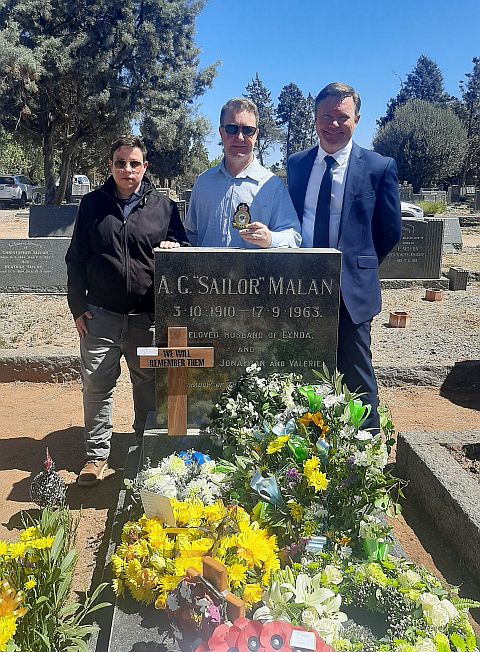
His relatives, Dr Yvonne Malan and Riel Malan, are seen in September 2023 visiting the grave with Cdr Leon Steyn from the SA Navy Museum, who wrote the article.
Return to Journal Index OR Society's Home page
South African Military History Society / scribe@samilitaryhistory.org